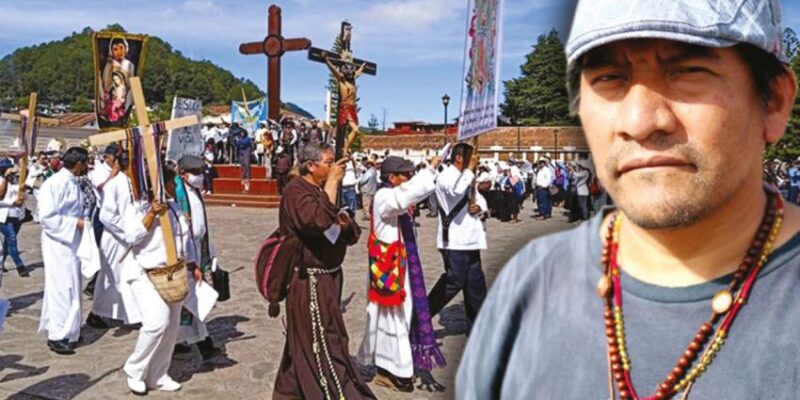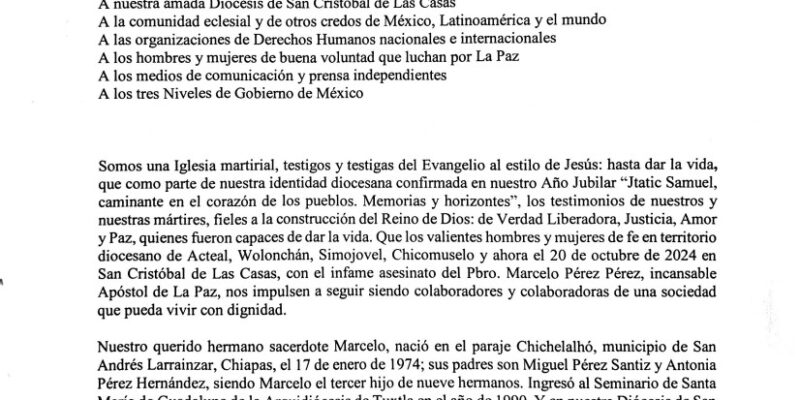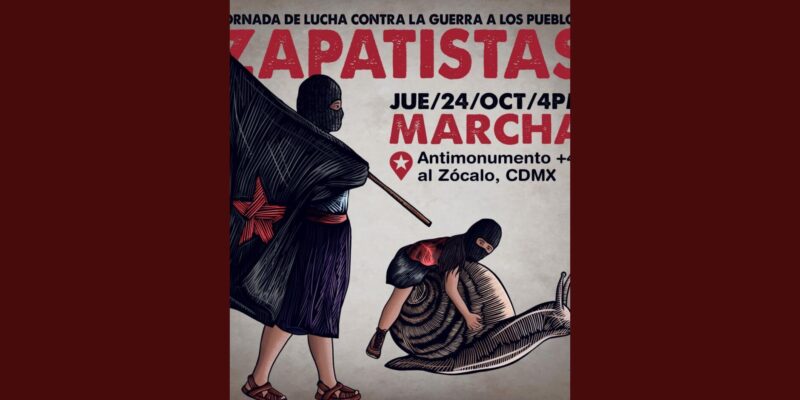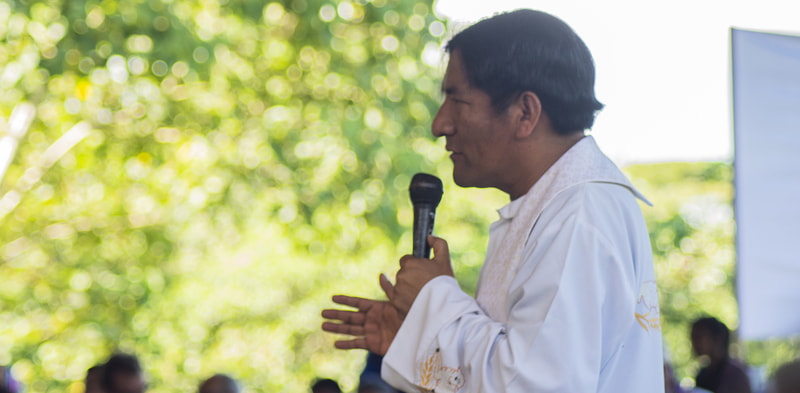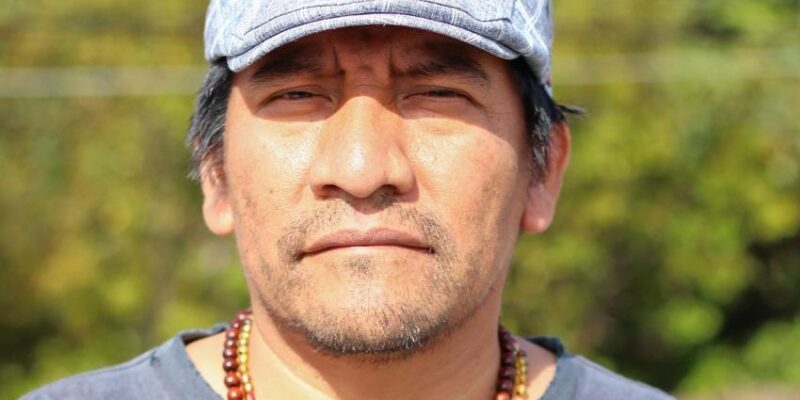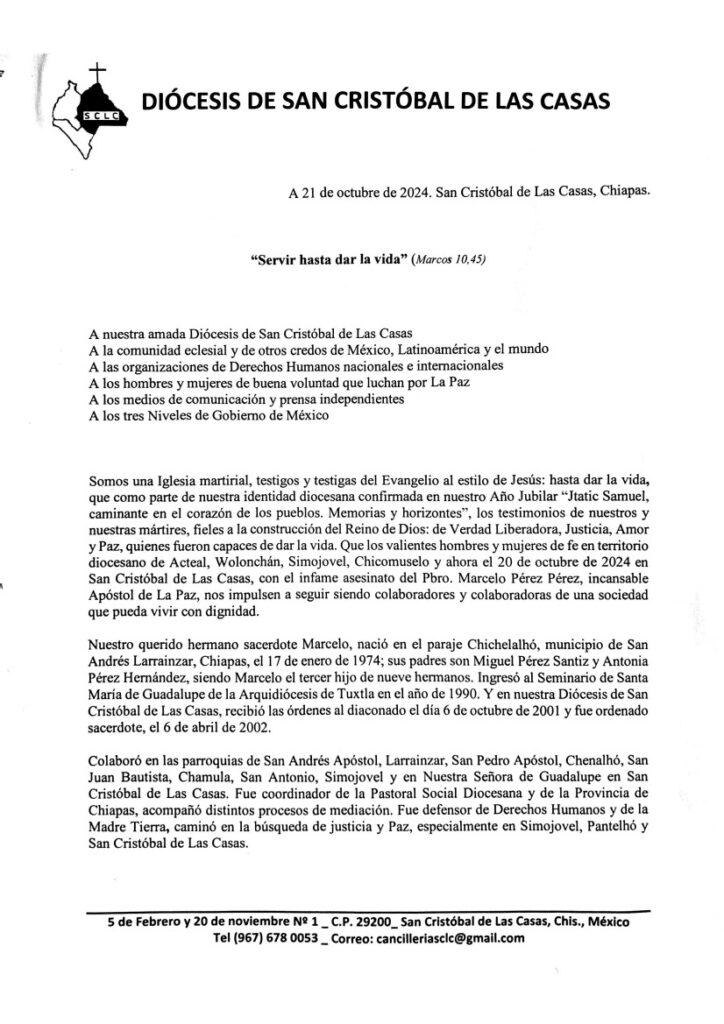
Las Abejas de Acteal: A pesar del atroz crimen cometido en contra del Padre Marcelo, nuestra esperanza no se rinde. ¡YA BASTA! DE DESTRUCCIÓN Y EXTERMINIO.
Organización Sociedad Civil Las Abejas de Acteal
Tierra Sagrada de los Mártires de Acteal
Acteal, Chenalhó, Chiapas, México.
22 de octubre 2024
Al Congreso Nacional Indígena
Al Consejo Indígena de Gobierno
A la Comisión Interamericana de Derechos Humanos
A las y los Defensores de los Derechos Humanos
A la Diócesis de San Cristóbal de Las Casas, Chiapas
A los Medios Libres y Alternativos
A los Medios de Comunicación Nacional e Internacional
A la Sociedad Civil, Nacional e Internacional
Hermanas y Hermanos:
Hoy, ha llegado el día de la siembra del cuerpo de nuestro hermano Padre Marcelo Pérez Pérez en su pueblo, al lado de los pilares de la iglesia de San Andrés Apóstol en el municipio de Larráinzar, conocido internacionalmente como Sakamch’en de los Pobres, en donde tuvieron sede los diálogos de San Andrés y en donde se firmaron los llamados Acuerdos de San Andrés sobre Derechos y Cultura Indígena, traicionados por el entonces presidente de México, Ernesto Zedillo Ponce de León.
A pesar del atroz crimen cometido en contra del Padre Marcelo, nuestra esperanza no se rinde, en medio de la espiral de violencia desbordada por la incapacidad política e insensibilidad humana de los gobiernos, tanto en Chiapas como en todo México.
El asesinato cobarde de nuestro querido Padre Marcelo, es el resultado del egoísmo y de la avaricia de la delincuencia organizada y de un sistema de gobierno que se ha hecho ciego y sordo por intereses políticos y económicos de los grupos de poder en México, interconectados con el crimen organizado; y así han minimizado los desplazamientos forzados, las desapariciones forzadas, los brutales asesinatos como en Chicomuselo, en Frontera Comalapa, en Los Altos de Chiapas y en otras partes de México.
Pero a pesar de esta violencia infame, nacen luces de esperanza y de memoria. Por ejemplo en este contexto, sobre la muerte y la impunidad, celebramos la memoria de jTotik Samuel que sigue viva en nuestras conciencias y en nuestro corazón: sabemos que también él sufrió amenazas de muerte y también sufrió junto a nosotras la masacre de Acteal, pero tuvo la fuerza y la sabiduría para defender a nuestros pueblos, y continúa siendo guardián de nuestros pueblos tseltales, tsotsiles, ch’oles y tojolabales, que en medio de la violencia y la muerte nos esforzamos en construir la paz, como hoy nos recuerda la carta de San Pablo “Jesús vino para anunciar el Evangelio de la Paz, para ustedes que estaban lejos, como a los que están cerca” (Ef. 2, 17)
En 1974, Jtotik Samuel abrió un espacio para encontrarnos en un congreso convertido en un movimiento digno y el comienzo de un nuevo amanecer, que tuvo como lema “La unión es nuestra fuerza hacia la libertad”. Abrió caminos a la esperanza y a la igualdad en la justicia, desafiando al sistema capitalista. Entre todos los representantes juntaron la palabra, que se convirtió en denuncia y acuerdos, despertando la conciencia de nuestras comunidades. Entendieron que el estado siempre tiene otra idea, que no es la de nosotros, que tenemos que comunicarnos para entender, lo que se estaba viviendo y lo que vivimos ahora, para caminar desde nuestras raíces con la fuerza de los pueblos, en un sólo corazón, hacia la liberación.
En este tiempo vivimos otros modos de esclavitud, que están impactando en nuestros pueblos y comunidades, como la que nosotros vivimos con nuestros hermanos de Pantelhó, víctimas de la violencia, sin poder salir a trabajar. Oímos en las noticias las violaciones a los derechos que sufren hermanos de otros pueblos, donde ya no pueden juntarse para platicar, tampoco organizarse para caminar juntos.
Antes de suceder el cobarde asesinato del Padre Marcelo, de por sí estaban ocurriendo graves agresiones, amenazas y despojos de sus tierras a nuestros hermanos zapatistas de la comunidad 6 de Octubre del municipio oficial de Ocosingo, Chiapas; situación denunciada por varias organizaciones sociales y defensores de derechos humanos. Sus vidas siguen en riesgo y debemos de estar atentos, sin perder de vista esta situación.
Lo que está generando el crimen organizado con la permisividad del gobierno de Chiapas y de México, por su ambición y avaricia de poder político y económico, es una guerra abierta de destrucción y exterminio contra quienes luchamos por nuestra autonomía, por quienes defendemos la Madre Tierra, la Paz y la Vida.
(Continuar leyendo…)Chiapas: Indignación internacional por el asesinato del sacerdote tsotsil Marcelo Pérez Pérez
Fuente: Avispa Midia
Por Jeny Pascacio
En portada: El padre Marcelo (al frente, con gorra) durante un evento en el ejido Candelaria, San Cristóbal de Las Casas. En enero del 2021, y tras los estragos de la pandemia del Covid19, se congregaron representantes del Movimiento en Defensa de la Vida y el Terrtitorio para articular estrategias en defensa de las comunidades indígenas chiapanecas. Foto: Aldo Santiago
Por su labor en la defensa de los pueblos indígenas de Chiapas, el párroco tsotsil Marcelo Pérez Pérez fue asesinado la mañana de este 20 de octubre, a unos metros de la parroquia del barrio de Cuxtitali en San Cristóbal de Las Casas, Chiapas, sur de México.
De acuerdo a las primeras declaraciones, el sacerdote salió del recinto tras oficiar la primera misa del domingo, se subió a su vehículo varado en la calle La Pera esquina con calle Franz Bloom. Segundos después recibió varios disparos con arma de fuego.
El estruendoso sonido alertó al barrio organizado de Cuxtitali y de inmediato se dieron cita vecinos y religiosos que se aproximaron para dar aviso a las autoridades y despedir al padre con rezos y cantos.
La Fiscalía de Asuntos Especiales y Distrito Altos realizó lo correspondiente al levantamiento del cuerpo que se encontró al interior de una camioneta marca Ford Titanium color blanco, con placas de circulación del estado de Chiapas. Así mismo inició la indagatoria, pero hasta ahora no hay detenidos.
Cuando el Servicio Médico Forense (Semefo) trasladó a Pérez Pérez la multitud que se hizo presente se despidió con lágrimas, velas y ¡vivas!. Después colocaron una bandera blanca en el campanario de la parroquia de Cuxtitali.
(Continuar leyendo…)

